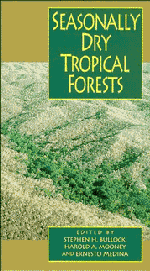Book contents
- Frontmatter
- Contents
- List of contributors
- Acknowledgements
- 1 Introduction
- 2 Dry forests of Central America and the Caribbean
- 3 Overview of the Brazilian caatinga
- 4 Savannas, woodlands and dry forests in Africa
- 5 Dry forest ecosystems of Thailand
- 6 The Cenozoic record of tropical dry forest in northern Latin America and the southern United States
- 7 Diversity and floristic composition of neotropical dry forests
- 8 Vertebrate diversity, ecology and conservation in neotropical dry forests
- 9 Diversity of life forms of higher plants in neotropical dry forests
- 10 Drought responses of neotropical dry forest trees
- 11 Plant reproduction in neotropical dry forests
- 12 Plant–herbivore interactions in Mesoamerican tropical dry forests
- 13 Biomass distribution and primary productivity of tropical dry forests
- 14 Nutrient cycling in tropical deciduous forests
- 15 Biology of the belowground system of tropical dry forests
- 16 Nitrogen trace gas emissions in a tropical dry forest ecosystem
- 17 Conversion of tropical dry forest to pasture and agriculture
- 18 Ethnobotany of the Mexican tropical dry forests
- Index
5 - Dry forest ecosystems of Thailand
Published online by Cambridge University Press: 07 September 2010
- Frontmatter
- Contents
- List of contributors
- Acknowledgements
- 1 Introduction
- 2 Dry forests of Central America and the Caribbean
- 3 Overview of the Brazilian caatinga
- 4 Savannas, woodlands and dry forests in Africa
- 5 Dry forest ecosystems of Thailand
- 6 The Cenozoic record of tropical dry forest in northern Latin America and the southern United States
- 7 Diversity and floristic composition of neotropical dry forests
- 8 Vertebrate diversity, ecology and conservation in neotropical dry forests
- 9 Diversity of life forms of higher plants in neotropical dry forests
- 10 Drought responses of neotropical dry forest trees
- 11 Plant reproduction in neotropical dry forests
- 12 Plant–herbivore interactions in Mesoamerican tropical dry forests
- 13 Biomass distribution and primary productivity of tropical dry forests
- 14 Nutrient cycling in tropical deciduous forests
- 15 Biology of the belowground system of tropical dry forests
- 16 Nitrogen trace gas emissions in a tropical dry forest ecosystem
- 17 Conversion of tropical dry forest to pasture and agriculture
- 18 Ethnobotany of the Mexican tropical dry forests
- Index
Summary
Introduction
Dry tropical forest vegetation in Thailand and adjacent parts of Southeast Asia exhibits structures and ecological processes very different from those characteristic of neotropical dry forests. Unlike the Pacific coast of Central America and México where dry forests are virtually all deciduous, evergreen forest types are widespread in the dry forest climatic regime of Southeast Asia. Evergreen dry forests in areas with 1200–1500 mm y−1 precipitation and deciduous forest in areas with up to 2300 mm y−1 are surprising occurrences in relation to climate–vegetation seen in dry neotropical forests. Many of these regional differences can be attributed to the poor nutrient status and low water-holding capacity of the shallow and infertile latosols and lithosols which predominate in Southeast Asia. Many other factors – historical, abiotic and genetic – are no doubt involved as well. In this review, we provide a broad biogeographic survey of the geography and dry forest communities of Thailand as an introduction to this region.
The literature on forest vegetation in Southeast Asia has been largely unavailable in Western libraries, thus limiting ecological interest in this important region. International concerns over global climate change and loss of biodiversity, however, have led to renewed interest in the structure and function of forest vegetation in Thailand (Round, 1988; Elliot, Maxwell & Beaver, 1989) as elsewhere. Also, future studies contrasting paleotropical and neotropical dry forests will undoubtedly lead to new perspectives on old problems, and to a much better understanding of the interactive nature of nutrient availability and seasonality in soil moisture which lead to broad patterns of forest dominance by evergreen or deciduous species.
- Type
- Chapter
- Information
- Seasonally Dry Tropical Forests , pp. 93 - 123Publisher: Cambridge University PressPrint publication year: 1995
- 53
- Cited by



